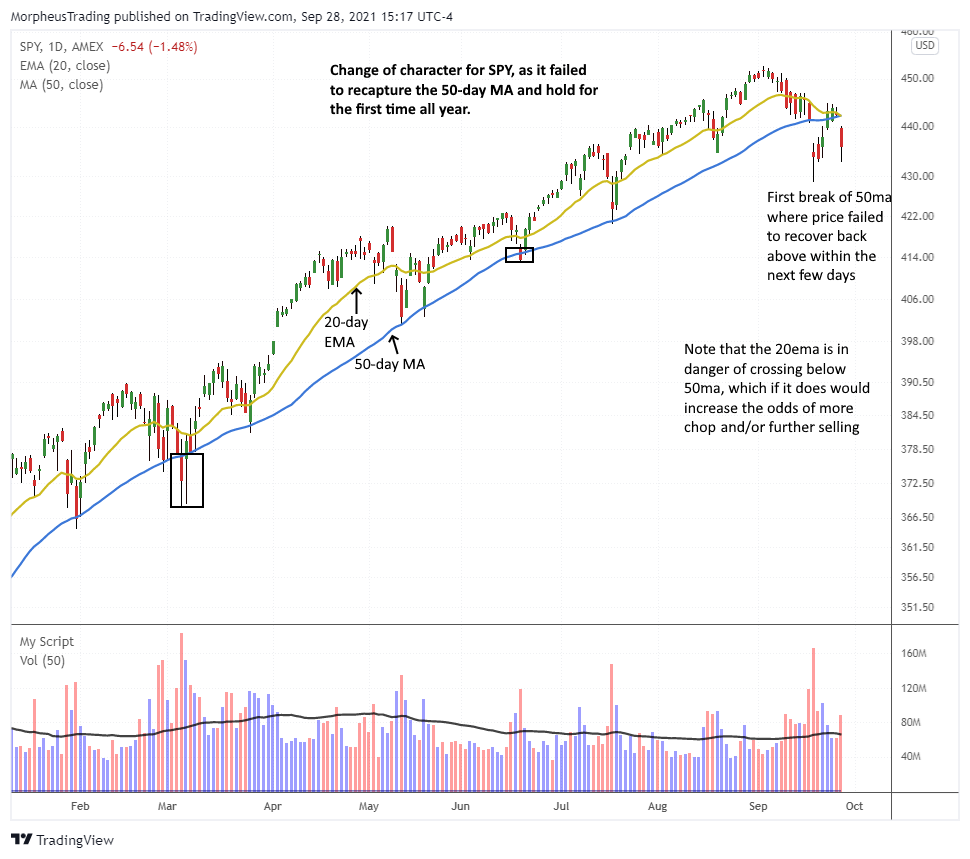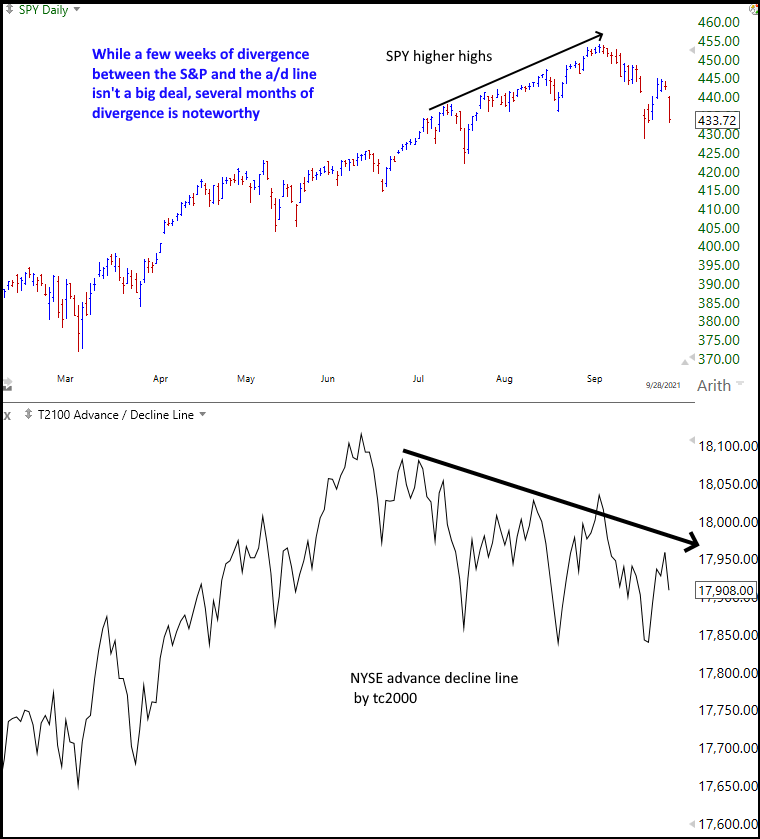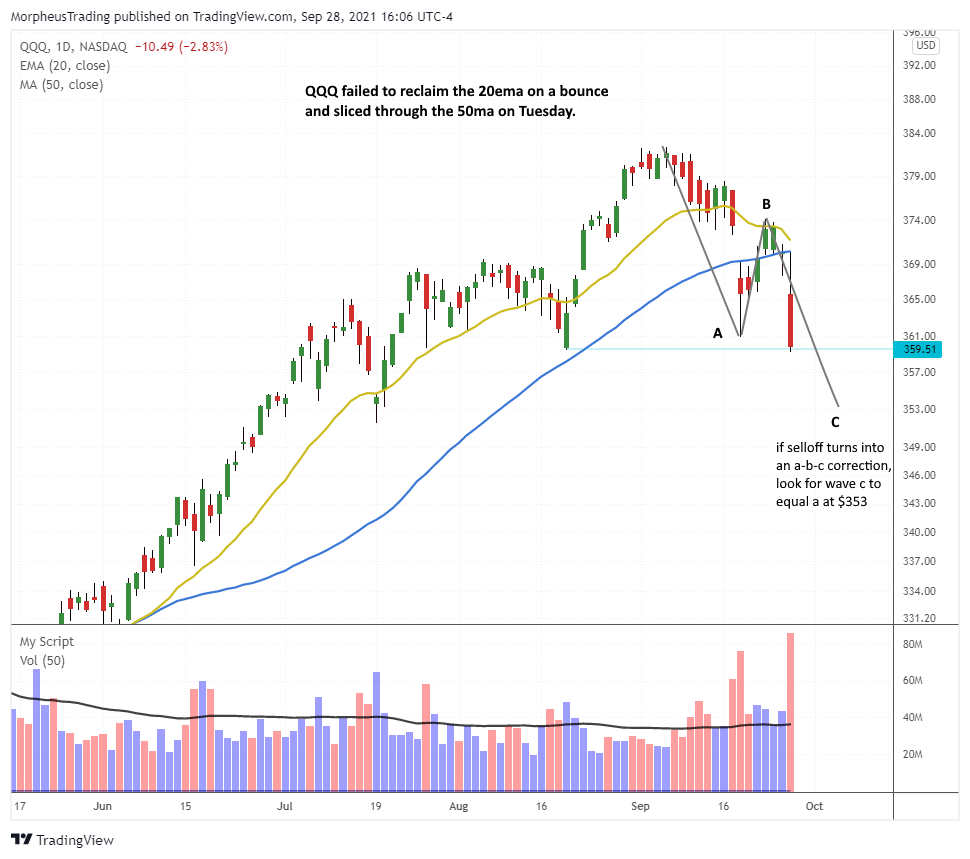The benchmark S&P 500 Index has broken its year-long uptrend and 50-day moving average. Will stocks simply rally back to their highs again–just like every other correction this year? The charts indicate this time may be different. Here’s why…
In a healthy uptrend, it is normal for a stock market index to occasionally pull back to support of its 50-day moving average–a reliable and powerful technical indicator.
Mutual funds, hedge funds, and other institutions typically view pullbacks to the 50-day moving average (50-MA) as low-risk buying opportunities in uptrending stocks.
We similarly focus on pullback buy entries in many of the top growth stocks we trade in our nightly stock report.
However, bullish sentiment can quickly erode when a stock or index fails to hold above its 50-MA after a price correction.
That’s the current situation in the S&P 500 and Nasdaq indices, both of which sliced through pivotal support of their 50-MAs after tumbling several percent lower on September 28.
Will stocks simply cruise back to new highs again–just as they have done after every price correction this year?
This time may be different!
Continue reading for our simple technical analysis that shows why you should be prepared for a bumpy road ahead–at least in the near-term.
A Definitive Change of Character
The uptrending S&P 500 has pulled back to support of its 50-MA nine times since the start of 2021.
Until now, every single touch of that 50-MA swiftly led to a bullish reversal back above that level the very next day.
But not this time.
The current breakdown below the 50-MA is different because it marked the second time in two weeks that the S&P 500 failed to hold above that pivotal support level.
Higher volume during the September 28 sell-off means institutions were selling as well–a massive distribution day.
Most notably, it was the first time all year the S&P 500 closed below its 50-MA and did not immediately jump back above it the following day.
The stock market’s sudden change of character is shown on the annotated daily chart of SPDR S&P 500 ETF ($SPY) below:
A broken uptrend and bearish crossover
The current breakdown in $SPY means the S&P 500 has broken support of this year’s dominant uptrend.
Furthermore, the declining 20-day exponential moving average (yellow line) is now in danger of crossing below the 50-day moving average.
This type of moving average crossover is a bearish indicator that would point to a potential trend reversal.
If that happens, we would expect further selling pressure in the near-term–or choppy price action at best.
If $SPY sees a relief bounce in the coming days, expect former support of the powerful 50-MA to now act as significant resistance.
After any support level is broken, remember that former support level becomes the new overhead resistance level.
Narrowing Leadership: The illusion of strong stock market action
The current technical breakdown below the 50-MA is not the only bearish change of character we have seen recently.
Behind the scenes, a stealth indicator that many investors ignore turned negative and has been weighing on the market over the past few months.
Here’s why it matters…
Bad Market Breadth
We rolled into the month of September with guns blazing and both the S&P 500 and Nasdaq Composite at fresh all-time highs.
That means most stock traders and investors were raking it huge trading profits over the summer…right???
Well, not really!
The reality is that narrowing leadership within both the S&P 500 and Nasdaq caused gains to be limited to a small handful of stocks.
As the main stock market indexes were rallying to record highs over the summer, the Advance/Decline line (AD line) was trending steadily lower.
This bearish divergence of the AD line means that market breadth has actually been worsening over the past several months.
Accordingly, many leading stocks actually registered losses or only minimal gains over the summer–despite the major indices trading at all-time highs.
On the chart below, notice how the NYSE Advance/Decline line (bottom section) was trending lower while the S&P 500 was trending higher (top section).
The NYSE Advance/Decline line peaked in June, but has been setting lower highs since then.
Now, we are starting to see the end result of that bearish divergence between the S&P 500 and AD line.
Nasdaq 100 breakdown
The Nasdaq 100 ETF ($QQQ) also just sliced through its 50-MA on heavy volume, suffering a 2.8% closing loss.
If there is follow-through on the September 28 sell-off, then we will look for a possible ABC correction to play out in the near term.
The potential ABC bearish scenario is shown on the daily chart of $QQQ below:
In the case of an ABC correction, note that wave C should be equal in length to wave A.
This would equate a potential downside target for $QQQ around $353 in the short-term.
Another possible scenario that could play out in the Nasdaq 100 is an “undercut” and rally off the prior swing low from August 19 (blue horizontal line).
In this case, we would look for the Nasdaq to snap back above the $360-$361 area within the next few days.
The Trading Plan
With both $SPY and $QQQ now trading firmly below their 50-day moving averages, the odds of further downside have increased.
As such, cash is king right now!
With the Wagner Daily market timing model now on a confirmed “sell” signal, we are protecting profits on the sidelines.
However, we are proactively scanning the markets for the next explosive winners and leading stocks that will once again emerge when stocks find support.
Don’t miss the next big bull run.
Subscribe now to be instantly notified of our exact entry, stop, and target prices of the best swing trade setups when our market timing model returns to a new buy signal.
In the meantime, remember to always trade what you see–NOT what you think!



